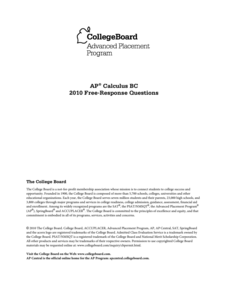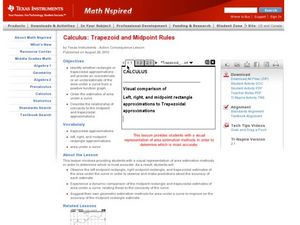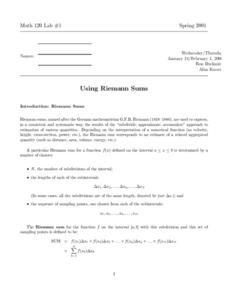College Board
2008 AP® Calculus BC Free-Response Questions
The AP® exam is not just about the calculations. By reviewing the free-response questions from 2008, teachers and pupils see that several items require justifications and explanations to gain full credit. The chief reader even points out...
College Board
2005 AP® Calculus BC Free-Response Questions
Differentiate between the exams. Using the Q&A document, teachers compare the free-response questions that BC test-takers see to those that AB test-takers see. The pupils see which questions come from AB content and also those that...
College Board
2002 AP® Calculus AB Free-Response Questions
Peek behind the curtain. Using a helpful resource, teachers and pupils see the way concepts appear on the AP® Calculus exam. Scholars use the questions to prepare for their own exams, gaining quality practice before test day. Questions...
College Board
2004 AP® Calculus BC Free-Response Questions
Given a set of questions, pupils realize the way the Calculus BC free-response exam asks questions. The items include both contextual and non-contextual questions. Both types are split into the calculator and non-calculator sections for...
College Board
2010 AP® Calculus BC Free-Response Questions
What do a zoo, snow, and a moving particle have in common? The six free-response items from the 2010 AP® Calculus BC exam allow teachers and pupils see how items may show up in context. Three of the questions are from only the BC portion...
Radford University
How Normal Are You?
It's completely normal to learn about normal distributions. An engaging lesson has young statisticians collect and analyze data about their classmates as well as players on the school's football team. They determine whether each set of...
Curated OER
Test on Section 6.1-6.6
Learners apply their knowledge of integration on this test. In this calculus lesson, students answer question about, riemann sums, integrals and calculate area under a curve. This lesson review these concepts and includes a test for the...
Curated OER
Lesson #100 The Fundamental Theorem of Calculus and Area Under the Curve
Learners explore the Fundamental Theorem of Calculus and apply the properties of definite integrals to solving equations. As a class, they explore formulas to use in evaluating integral yields in regions above and below the x-axis....
Curated OER
Z-Scores
Learners solve problems by identifying the percent of area under the curve. In this statistics lesson, students discuss z-scores as they calculate the different percentages under the bell curve. They calculate the standard deviation.
Curated OER
Trapezoid and Midpoint Rule
Students solve problems of area using the trapezoid and midpoint rule. In this calculus lesson, students take the derivative of the functions as they approximate the area under a curve. They calculate the exact area using the area formula.
Curated OER
Impulse/Momentum Lab
Students investigate the relationship between force and momentum using motion detectors and sensors. In this physics lesson, students graph experimental results. They calculate impulse using the area under the graph.
Curated OER
Riemann Sums and Error Stacks
For this Riemann sums worksheet, students use accumulation to find the estimate for the area of a given shape. Students use Riemann sums to estimate the area under the curves and error stacks to bound the error of their approximation....
Curated OER
Calculus Review
In this calculus worksheet, students figure out the volume of an area under the curve rotated about the x and y axis. There are 2 questions on this worksheet with various sub-section.
Curated OER
Fundamental Theorem of Calculus
In this fundamental theorem worksheet, students give antiderivatives of functions, find the area under a curve, and evaluate continuous functions. This two-page worksheet contains ten problems.
Curated OER
Using Riemann Sums
In the Riemann sums instructional activity, students use Riemann sums to estimate the area under a curve. They calculate intervals and subintervals. Students create a graph picturing the intervals. This seven-page instructional...
Curated OER
Exploring the Normal Curve Family
Pupils find different characteristics of the bell curve. In this statistics lesson, students analyze a family for a specific characteristic. They identify the shape, center, spread and area as they analyze the characteristic of the...
Curated OER
Worksheet 17: Writing Equations
In this equations worksheet, students graph the curve represented by pairs of parametric equations. They determine the slope of the line tangent to a given graph. Students find the area region lying under the curve. This two-page...
Curated OER
Chapter 34: Income Inequality and Poverty
Displaying the causes, trends, and effects of income inequality, this presentation covers the wide gap between wealth and poverty in the United States. The navigational tool will help lecturers guide the conversation. The key terms in...
EngageNY
Modeling Riverbeds with Polynomials (part 2)
Examine the power of technology while modeling with polynomial functions. Using the website wolfram alpha, learners develop a polynomial function to model the shape of a riverbed. Ultimately, they determine the flow rate through the river.
Curated OER
Numerical Methods of Integration
Pupils review Riemann Sums with rectangles, used to approximate the area under a curve. They listen as the teacher introduces the Trapezoidal Rule to approximate the area under a curve. Students use Simpson's Rule to find the area under...
Curated OER
Solar Flare Reconstruction
In this solar flare reconstruction worksheet, students read about the 'saturation' point of satellite detectors when solar flares are at their most intense phase of brightness. Students are given x-ray flare data and they re-plot the...
Curated OER
Solid Rocket Boosters-II
For this solid rocket boosters worksheet, students solve 2 problems using a grid showing a cross section of a proposed solid rocket booster. Students complete the grid and shade the rings of combustion in 15-second step intervals. They...
Curated OER
Percentiles
Students analyze the bell curve and make predictions. In this statistics lesson, students calculate the percentile to the left of the curve. They then are given the percentile and create the graph from the data.
Curated OER
Mini Exam on Calculus
In this calculus instructional activity, students differentiate equations and calculate rate of change. They find the area and volume under a curve. There are 18 questions on this test.























